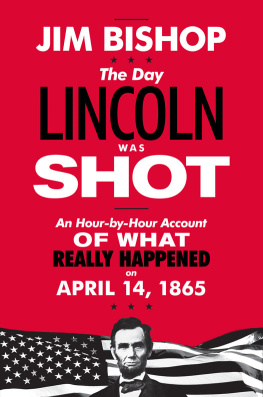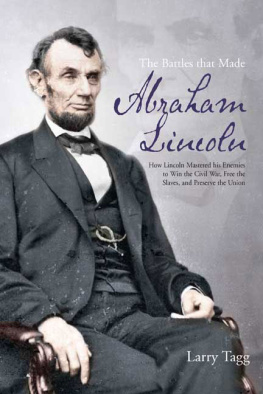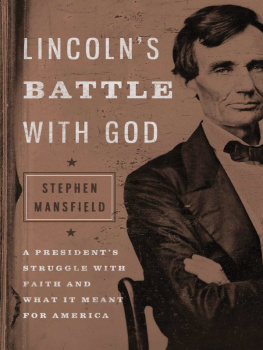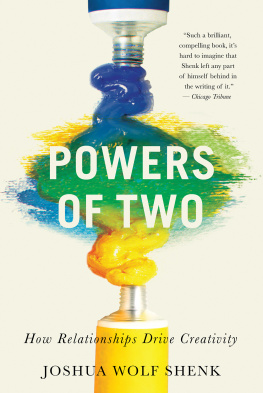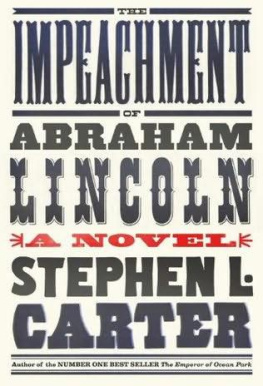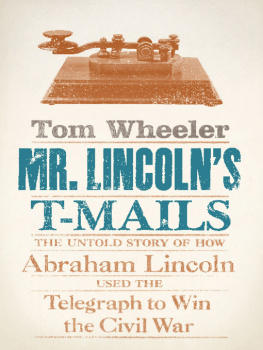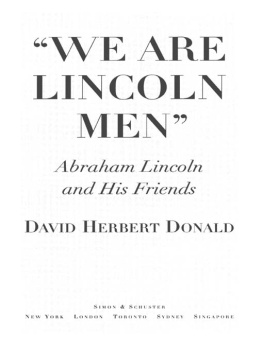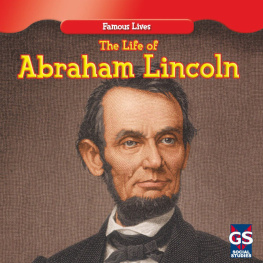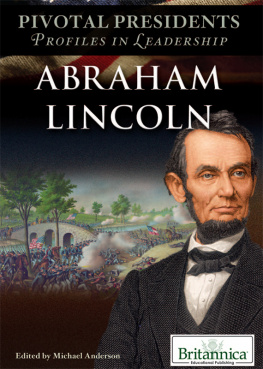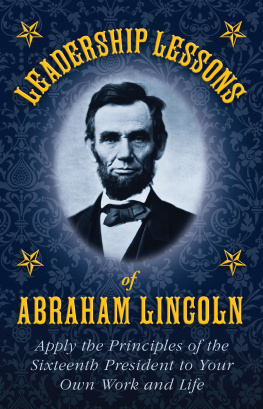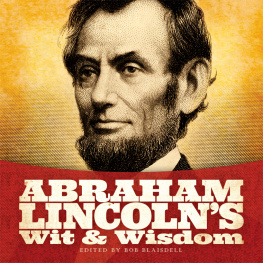ABRAHAM LINCOLN
Abraham Lincoln
A Life
VOLUME TWO
Michael Burlingame

2008 The Johns Hopkins University Press
All rights reserved. Published 2008
Printed in the United States of America on acid-free paper
Johns Hopkins Paperback edition, 2013
9 8 7 6 5 4 3 2 1
The Johns Hopkins University Press
2715 North Charles Street
Baltimore, Maryland 21218-4363
www.press.jhu.edu
The Library of Congress has cataloged the hardcover edition of this book as follows:
Burlingame, Michael, 1941
Abraham Lincoln : a life / Michael Burlingame.
p. cm.
Includes bibliographical references and index.
ISBN-13: 978-0-8018-8993-6 (hardcover: alk. paper)
ISBN-10: 0-8018-8993-6 (hardcover: alk. paper)
1. Lincoln, Abraham, 18091865. 2. PresidentsUnited StatesBiography. I. Title
E457.B95 2008
973.7092dc22
[B] 2007052919
A catalog record for this book is available from the British Library.
ISBN-13: 978-1-4214-1058-6
ISBN-10: 1-4214-1058-3
Special discounts are available for bulk purchases of this book. For more information, please contact Special Sales at 410-516-6936 or specialsales@press.jhu.edu.
The Johns Hopkins University Press uses environmentally friendly book materials, including recycled text paper that is composed of at least 30 percent post-consumer waste, whenever possible.
For Lewis E. Lehrman, Lincolnian extraordinaire
CONTENTS
Illustrations follow
ABRAHAM LINCOLN
The Man Does Not Live Who Is More
Devoted to Peace Than I Am,
But It May Be Necessary to Put the Foot
Down Firmly
From Springfield to Washington
(February 1122, 1861)
The ever-obliging Lincoln agreed to undertake a taxing, circuitous, 1,900-mile train journey from Springfield to Washington in order to accommodate Republican friends in various states where they wanted him to speak. There were obvious drawbacks: the trip would be tiring, he would be exposed to potential assassins, and such a journey would not suit Lincolns taste for simplicity and aversion to any form of pomp. Moreover, though he would have to speak often, he could say little, for he wished to postpone until the inauguration any mention of his policy regarding the swiftly evolving secession crisis. Because the journey would be indirectIndianapolis, Cincinnati, Columbus, and Pittsburgh, then a detour through Cleveland, Buffalo, Albany, New York, Trenton, Philadelphia, and Harrisburgit would consume twelve days. To demonstrate his indifference to assassination threats, Lincoln would have preferred a more direct route than the roundabout one finally selected. (John W. Garrett, president of the Baltimore and Ohio Railroad, said that Lincoln abandoned the idea of coming to Washington via Wheeling [Virginia], in consequence of certain alleged threats of violence from parties in Virginia and Maryland.)
These considerations did not deter Lincoln, for he believed that official invitations from state legislatures could not be ignored. John Hay, perhaps reflecting Lincolns thoughts, offered another reason for his decision: The progress of the President elect cannot but be fortunate in its influence upon the tone of public feeling in the Union. The devotion which men in general feel for their government is a rather vague and shadowy emotion. This will be intensified, and will receive form and coloring, by personal interviews of the people themselves with their constitutional head.
Other concerns doubtless influenced Lincoln as he pondered whether to take a long, slow journey to the nations capital. In selecting a cabinet, he told Thurlow The train trip would allow him to consult with Republican leaders outside Illinois about patronage and policy matters. Moreover, he might inspire the people he addressed in Indiana, Ohio, Pennsylvania, New Jersey, and New York with the same kind of confidence that he had generated among juries and voters in the Prairie State. Lincoln understood that those who elected him were eager to see what he looked like, and he was willing to satisfy their curiosity.
Originally, Lincoln had intended to have his wife and younger sons join him in New York for only the final leg of the trip. He evidently wanted to spare them the fatigue of the longer journey. On February 9, he changed plans because General Scott advised that his wifes absence from the train might be regarded as proceeding from an apprehension of danger to the President. This must have pleased Mary Lincoln, who was eager to accompany her husband. At the last minute, however, the plan was again altered, for reasons that are not entirely clear, and Mrs. Lincoln was not aboard when the train left Springfield. (She joined it at Indianapolis the next day.)
En route from the Illinois capital to the U.S. capital, Lincoln ended months of public silence with a flurry of speeches foreshadowing his eagerly awaited inaugural address. But as his train zigged and zagged its way eastward over the tracks of two dozen different railroads, his rhetoric seemed to zig and zag between confrontation and conciliation. Was he a hawk or a dove? Some days he seemed to be the former, other days the latter.
The Trip Begins
The train consisted of three ordinary coaches and a baggage car; Lincoln occupied the rear car. The entourage included his eldest son, Robert, and his two secretaries (John G. Nicolay and John Hay), as well as journalists, political allies, and friends. For protection, a military escort was arranged, but to avoid a bellicose appearance, some of its members joined the party later. Among those guarding the president-elect were army officers who volunteered for that duty while on leave, including Colonel Edwin V. Sumner, Captain John Pope, Captain William B. Hazen, Major David Hunter, and Captain George Whitfield Hazzard. Assisting them were James M. Burgess, whom the governor of Wisconsin detailed to Springfield as a bodyguard; Thomas Mather, adjutant general of Illinois; Ward Hill Lamon, Lincolns burly colleague at the bar and close personal friend; and Elmer E. Ellsworth, a young militia leader who had achieved national renown and was a surrogate son to Lincoln. The president-elect denied the necessity for such an escort, insisting that there was no danger whatsoever. He wanted to avoid appearing as though he traveled under guard.
In charge of travel arrangements was William S. Wood, a one-time jeweler and hotel manager who came to Springfield in January 1861 at the suggestion of Seward, Weed, and their friend Erastus Corning, a railroad manager, prominent New York Democrat, and relative of Wood. Seward claimed that Wood had had vast experience with railroads, had organized long excursions, and knew many railroad officials. Wood was handsome, self-important, and condescending. On the trip he paid close attention to the whims and caprices of Mrs. Lincoln.
As the train rolled eastward on the morning of February 11, Lincoln took a pencil and on a large pad wrote out a speech that he was to deliver in Indianapolis later that day. As he filled the sheets, his secretaries took them and made copies. John Hay reported that [s]omething of the gloom of parting with neighbors and friends, bidding farewell to the community in the midst of which he has lived for a quarter of a century, seemed to affect him. He was abstracted, sad, thoughtful, and spent much of his time in the private car appropriated to his use.
And so it went for the next twelve days. As Nicolay recalled, it is hard for anyone who has not had the chance of personal observation to realize the mingled excitement and apprehension, elation and fatigue which Mr. Lincoln and his suite underwent, almost without intermission for the period of nearly two weeks during this memorable trip.
Next page

